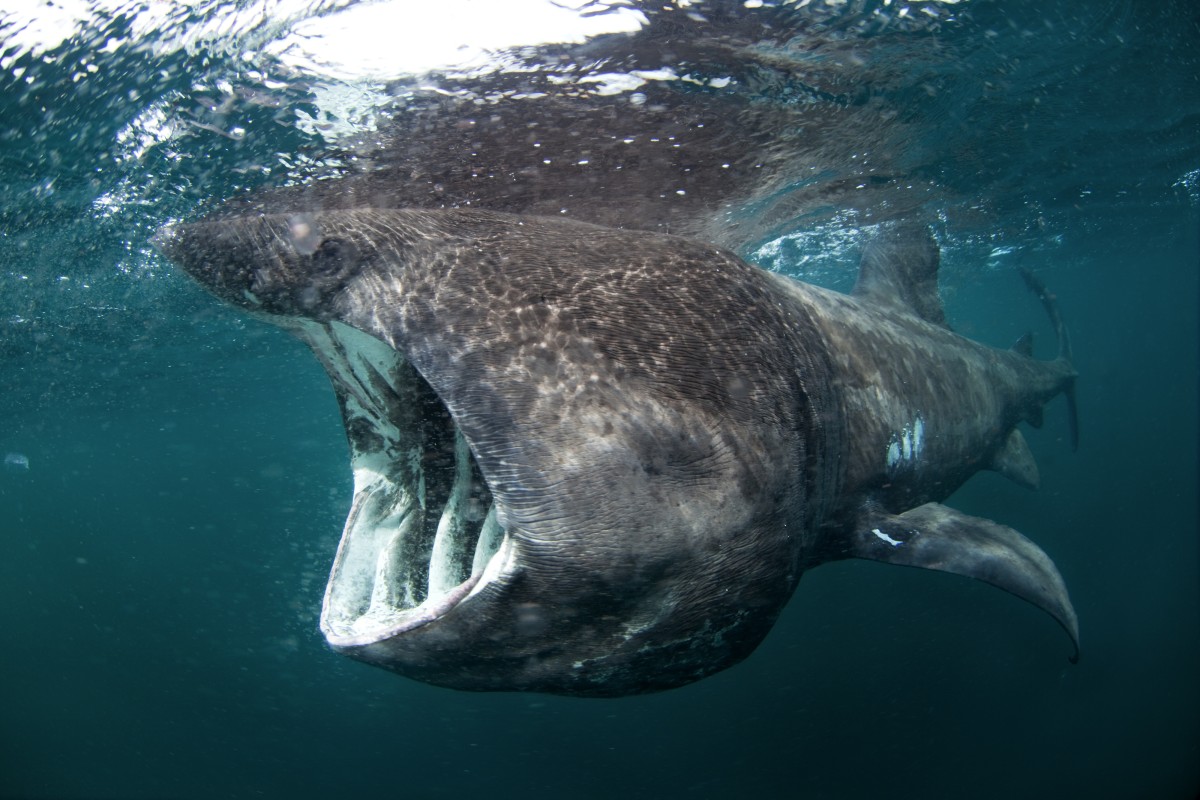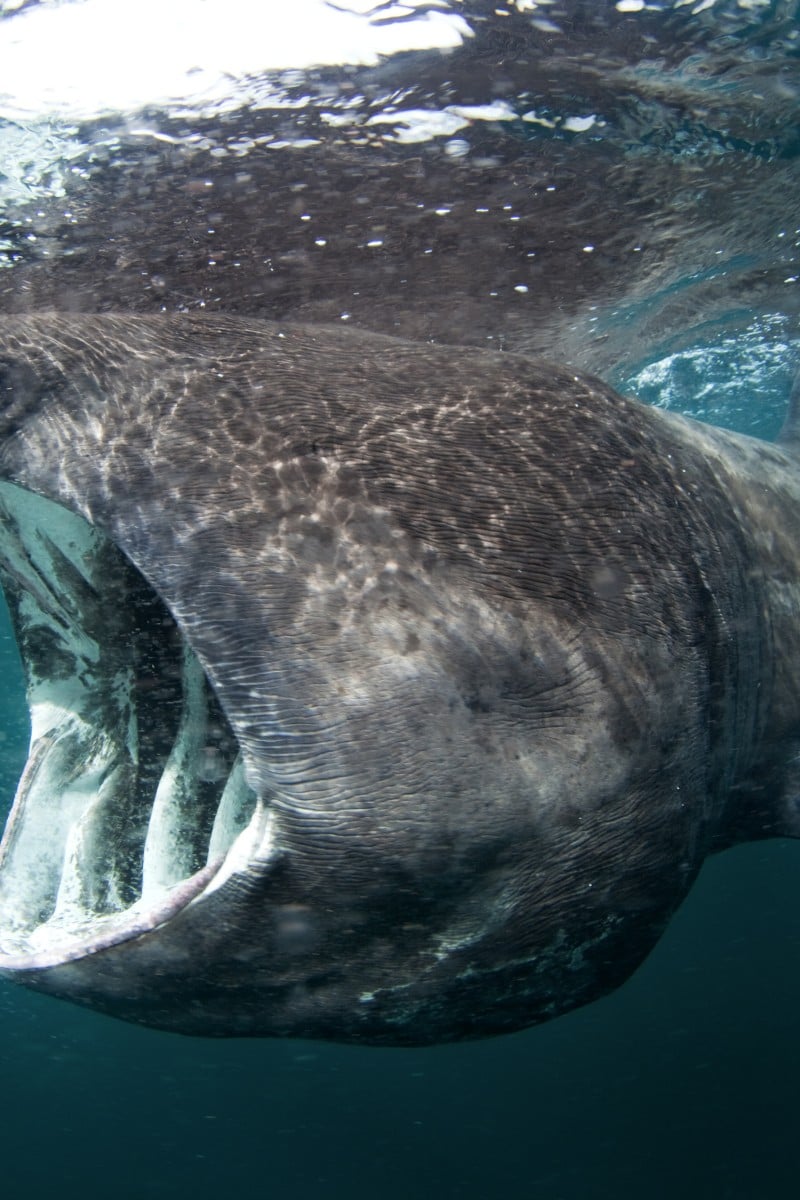 The basking shark looks ferocious but mainly feeds on plankton.
The basking shark looks ferocious but mainly feeds on plankton.10 Basking Shark
Scientific name: Cetorhinus maximus
The large and monstrous basking shark can grow to more than 10 metres long, making it the second largest fish in the ocean. It has a huge mouth that can span more than one metre wide. Despite its ferocious appearance, the basking shark is a type of filter-feeding shark and mainly feeds on plankton.
It swims with its mouth open and catches whatever goes through it. When water passes through its gills, the spines of the gill rakers separate the plankton from the water. The shark then closes its mouth and pumps water out through its gills. Each year it sheds and regrows its gill rakers.
The basking shark is a migratory fish. They can be found travelling through the Mediterranean Sea, the Pacific Ocean, the Atlantic Ocean, the Sea of Japan, near New Zealand, and Southern Australia, and usually travel in groups of about 100. Its name, comes from its habit of swimming very close to the surface with its dorsal fin out of the water - to "bask" means to laze in the sun.
9 Wobbegong
Scientific name: Orectolobidae
The word "wobbegong" is believed to come from an Australian Aboriginal language, meaning "shaggy beard". It refers to the whisker-like barbels around its nose, and flaps of skin that looks like tiny fins around its mouth and eyes, and on the side of its head. It is mostly found in shallow waters around Australia and Indonesia, usually in bays, caves, rocky bottoms, and reefs.
The wobbegong is a bottom-dwelling shark and usually stays close to the ocean floor. Its green-brownish skin is covered in a unique pattern of bold markings that helps it to camouflage perfectly in the sand.
The wobbegong has poor eyesight and only hunts at night. Even as it hunts, it moves in a sluggish manner, dragging its flat body along the seabed, like a carpet.
8 Nurse Shark
Scientific name: Ginglymostoma cirratum
Affectionately known as the "couch potato of the shark world", the nurse shark leads a sedentary life, just like the wobbegong. It is non-migratory and adapts to colder water temperatures by decreasing its activity level.
It is usually found in the warm, shallow waters of the western Atlantic and eastern Pacific oceans, and rests during the day in large groups (with groups of two to 40 sharks piling up on top of each other). However, it hunts alone at night. The nurse shark is a bottom dweller and catches its prey by sucking them into its mouth, making a slurping sound.
It also uses its strong jaws to crush and eat shellfish and coral, but prefers to feast on fish, shrimps, and squid. Its teeth grow like a dental conveyor belt - new rows of teeth pop out towards the back and push the older ones forward until they fall out.
The 10 deadliest snakes in the world
7 Horn Shark
Scientific name: Heterodontus francisci
The horn shark gets its name from its short blunt head and the high ridges above its eyes. It is known for its beautiful spiral-shaped egg cases.
Its scientific name "heterodontus" means "different teeth", referring to its combination of teeth - some are sharp and others are specially used for crushing invertebrates like crabs, shrimps and their favourite food, sea urchins. Some horn sharks even have purple-stained teeth from eating too many sea urchins!
Horn sharks are slow swimmers, and have been known to crawl along the bottom of seabeds using their fins. Unlike other sharks, the horn shark prefers to stay put in the same area: one was even found in the exact spot where it had once been caught, tagged and released 11 years earlier. The longest distance a horn shark is known to have travelled is 16 kilometres. It can be found off the coast of Southern California and Mexico.
6 Angel Shark
Scientific name: Squatina
This is a very special type of shark. It has a flat body with extremely long pelvic and pectoral fins, and is often mistaken for rays. But unlike rays, this bottom-dwelling shark uses its long fins to move around. It also has five pairs of gills located on the lower side of its body.
It is carnivorous and usually eats fish, squid, krill, lobsters, and mollusks. It can grow to two-and-a-half metres and weigh around 35 kilograms. It is nocturnal and spends most of the day buried in the seabed and ocean rocks.
There are 23 species of angel shark and they are found all around the world. This species has very large mouths with razor-sharp teeth found at the end of a blunted snout. Young angel sharks have ocellus - fake eyes - on their bodies to help defend them against predators. These disappear once they reach adulthood. Angel sharks are ambush predators that lie motionless hidden in the sand as it waits for prey to appear. When its prey gets close enough, it grabs it in a tenth of a second.
5 Saw Shark
Scientific name: Pristiophoriformes
Easily identified by its long, saw-like snout, the saw shark is an odd-looking fish. It has sharp teeth protruding from the edges of its snout, which are used to compete with other sharks and attack its prey. The saw shark also has a pair of barbels in the middle of its snout, which helps it to find its way around and locate vibrations of moving prey.
Its diet consists of different types of fish, crustaceans and squid. The saw shark is oviparous, meaning its eggs hatch inside the female's body. Young saw sharks are born with folded teeth so that they do not injury their mother during the birth.
There are around eight different species and they can be found in the waters of Japan, Australia, and South Africa. Saw sharks can live as a solitary creature, or be a part of a group called a school.
10 butterflies you don't know about
4 Goblin Shark
Scientific name: Mitsukurina owstoni
With its unusual appearance and ghostly complexion, the goblin shark looks like a prehistoric sea monster. It is rarely sighted, and is the only living species of a family of sharks that has become extinct. As such, the goblin shark is sometimes referred to as a "living fossil".
It has a long, bladelike snout filled with receptors that pick up its prey's movements. The goblin shark sweeps its snout back and forth over the seabed, just like a metal detector, to find its food. The goblin shark lives in very deep water, and it is thought to be a slow swimmer with extremely bad eyesight. Instead of hunting down prey, it waits for prey to come near it.
As such, it has developed a unique "slingshot" way of feeding, thanks to its protruding jaws. Its jaws are attached to elastic tissues and when prey comes within striking distance, the jaw juts out, allowing the shark to catapult its entire mouth forward at an astonishing speed of three metres per second!
3 Frilled Shark
Scientific name: Chlamydoselachus anguineus
The frilled shark is one of the most fascinating (and terrifying-looking) creatures in the water. It looks like an underwater snake with a long, smooth body that coils and bends just like the legless reptile. Its face resembles a snake, too; it has deep-set eyes and, unlike other sharks, its jaw is at the end of its snout instead of underneath it. The frilled shark gets its name from the six gill slits on each side of its body, that form a frill-like collar at the front of its throat.
An adult frilled shark can grow up to two metres, and while it is smaller than some of the sharks on this list, it is by no means less menacing. The shark's snout is lined with about 300 teeth, divided into 25 rows. The teeth are fork-shaped and face backward, making it practically impossible for its prey to escape.
The frilled shark lives very deep in the ocean, and is hardly seen. Also, captured frilled sharks never live long outside their natural cold, high-pressure environment.
2 Great Hammerhead Shark
Scientific name: Sphyrna mokarran
The Great Hammerhead Shark is an apex predator. It is the largest of nine species of hammerhead sharks and can be easily recognised by its unique hammer or shovel-shaped heads (cephalofoils). The two extensions give the great hammerhead shark 360-degree vision, allowing it to see above and below it at all times. It lives in warm temperate and tropical waters in the Atlantic, Pacific, and Indian Oceans, and migrates to cooler waters in the summer.
Adult great hammerhead shark primarily feed at dusk and feed on stingrays, invertebrates, fish and other sharks. Its favourite prey is rays, which it pins down to the seabed with its head. It then bites the ray's fins to prevent it from moving and eats it whole. Some great hammerhead shark have been found with stingray and catfish barbs sticking out of their mouths, suggesting they are immune to stingray and catfish venom.
1 Great White Shark
Scientific name: Carcharodon carcharias
Best known for its role in the film Jaws, the great white shark is one another apex predator with exceptional speed and highly developed sensitivity. It is mostly found along the coasts of Australia, South Africa, California, and the northeastern United States. It is also the world's largest predatory fish, and can grow to be about six metres and weigh more than 2,000 kilograms.
Also called the great white, this fearsome shark can detect one drop of blood in 100 litres of water, and sense blood up to five kilometres away. Not surprisingly, it is a carnivore, and its diet consists of whales, seal lions, seals, and other dead animals. It usually takes its prey by surprise, positioning itself under its unsuspecting victim before bursting out of the water. Although the great white is often portrayed as a man-eater, it is responsible for just five to 10 human attacks per year.
Vocabulary
apex predator: a predator at the top of a food chain that is not preyed upon by any other animal
barbel: a slender, whisker-like sensory organ near a fish's mouth
bottom-dweller: a fish that lives and feeds on the bottom of a body of water
dorsal fin: an unpaired fin on a fish's back
invertebrate: a type of animal that does not have a backbone
migratory: moving from one place to another at different times of the year
sedentary: when used to talk about animals, it means staying or living in one place
pectoral fin: the fin on each side of a fish near the front of its body, used for controlling its direction and speed

